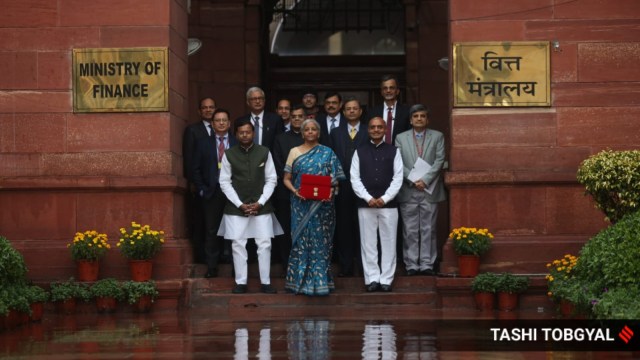If the Interim Budget in 2019 was all about relief to salaried individuals, farmers and unorganised workers, the one in 2024, in stark contrast, was about sticking to fiscal prudence. But 10 years in power later, the BJP’s political framing of the economy will be a “white paper” that Finance Minister Nirmala Sitharaman has promised in the Interim Budget to show what it was pre-2014, and the “step-by-step mending” this government had to do.

In 2019, the loss in Assembly elections in three Hindi heartland states — Rajasthan, Madhya Pradesh and Chhattisgarh — had pushed the government to go against the conventional wisdom of Prime Minister Narendra Modi of not showering freebies. Then Finance Minister Piyush Goyal had announced the Pradhan Mantri Kisan Samman Nidhi (PM-Kisan) along with a pension for unorganised sector workers and some relief to entry-level Income Tax payers.
The government has now stuck to just the required tenet of a vote-on-account to manage its expenses for a few months before the formation of the next government after the upcoming general elections. It, however, outlined the direction of its proposed welfare measures, stating its intent to come out with a detailed roadmap for “Viksit Bharat” in July.
After 10 years in power, with Lok Sabha elections a few months away, the government decided to list the differences between the country’s current economic position as compared to 2014, when the NDA government took charge, with a “White Paper” in Parliament.
“In 2014, when our government assumed the reins, the responsibility to mend the economy step-by-step and to put the governance systems in order was enormous. The need of the hour was to give hope to the people, attract investments, and build support for the much-needed reforms. The government did that successfully, following our strong belief of ‘nation-first’,” she said.
“The crisis of those years has been overcome, and the economy has been firmly put on a high sustainable growth path with all-round development. It is now appropriate to look at where we were till 2014 and where we are now, only for the purpose of drawing lessons from the mismanagement of those years. The government will lay a White Paper on the table of the House,” Sitharaman said in her speech that lasted less than an hour.
Story continues below this ad
The sops in the 2019 Interim Budget had come right after the BJP failed to form the government after the Assembly elections in Chhattisgarh and Karnataka towards the end of 2018. The then Finance Minister, Piyush Goyal, had catered to the three significant groups of electorate – farmers, unorganised workers and salaried class.
https://www.youtube.com/watch?v=WSX18KYjCJo?si=rQAuTFP6qyA-nWa2
Goyal had then announced the inception of the PM-Kisan, which promised an annual benefit of Rs 6,000 to all farmers owning up to 2 hectares of land. The then government had also announced a monthly pension of Rs 3,000 for workers above the age of 60 years in the unorganised sector, under the Pradhan Mantri Shram Yogi Maandhan (PM-SYM). Goyal had also said that individuals with an annual taxable income not exceeding Rs 5 lakh would receive a full tax rebate of Rs 12,500.
In contrast, there were no changes announced by Sitharaman in the direct and indirect tax regime in the Budget for 2024-25. However, in the days preceding the Interim Budget, the government did resort to several import duty changes, including a hike in duty on gold findings and mobile phone components.
Story continues below this ad
This was done in a similar fashion to the Interim Budget of 2004-05, when, in the final year of the A B Vajpayee-led NDA government, then Finance Minister Jaswant Singh announced changes in the stamp duty structure, revival packages for the tea and sugar industries, and merging of dearness allowance with basic pay. These weren’t the only measures taken as Singh had already announced major changes in both direct and indirect taxes in January 2004, including a cut in the peak rate of customs duty on non-farm goods from 25 per cent to 20 per cent, lower customs duty on project imports, coal and the power sector, and abolishment of the special additional duty on customs duty of 4 per cent.

































